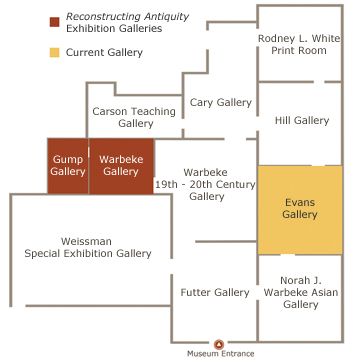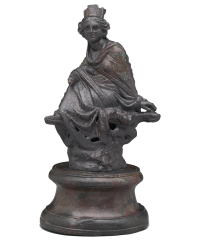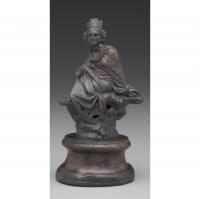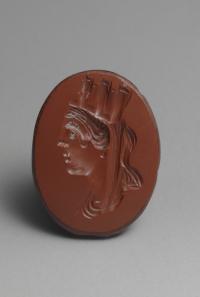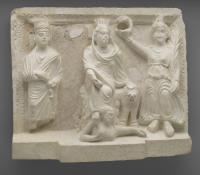Tyche as symbol of good fortune for the metropolis of Antioch, Syria
Learn more about the object below
Tyche (ΤΥΧΗ, τύχη in Greek), the Greek goddess of fortune, originated in the 4th century BCE, flourished in the Hellenistic period, and was adopted by the Romans as Fortuna. She controlled the fortunes of individuals, armies, cities, and kingdoms. She also served as the patron goddess and protector of cities, as Athena did for Athens. Protective deities for cities are known as early as Homer, but Tyche was the first to serve exclusively in this role. Tyche was ubiquitous, and the Tyche of Antioch statue was among the most pervasive and influential images in the ancient world.
Tyche and the Fortunes of Cities Tyche personified the city as well as controlled its fate. She served as the city’s symbol, and images of the goddess—generally a statue erected in a temple or civic space—showed her wearing the city walls as a crown. Tyche statues often incorporated famous or important features of the city, such as the River Orontes that flowed through Antioch and appears on this nearby coin as a personification swimming at the goddess’s feet. Images of Tyche wearing the mural crown are common symbols on coins of the late Hellenistic and Roman periods, especially in the eastern Mediterranean.
Every man, woman, and child, whether Alexander the Great, the empress Faustina, or an old market woman, had his or her own personal Tyche. Images of the goddess were worn as jewelry to protect the wearer. Tyche brought both good and bad fortune, and wearing a ring with an image of the goddess was also thought to ward off her malevolent tendencies. Tyche/Fortuna was also an important member of the household gods. Even Roman emperors (Antoninus Pius, Marcus Aurelius, and Septimius Severus, according to one ancient source) kept a statue of Fortuna in their bedroom.
The city of Antioch commissioned a statue of Tyche by the sculptor Eutychides in the early 3rd century BCE. Although it has not survived, it was famed in antiquity and its image preserved through ancient copies. Described by ancient writers, the Tyche of Antioch became the model for those of other cities, appearing for centuries on coins across the Roman Empire and in sculpture in cities as far east as Palmyra and Dura-Europos. The Tyche of Palmyra shown here, made nearly 500 years after its Antioch ancestor, shows a local adaptation: Antioch’s Orontes River is replaced by the spring that watered Palmyra’s oasis.
Label texts by Susan Matheson, Molly and Walter Bareiss Curator of Ancient Art, Yale University Art Gallery
Suggested readings:
J.J. Pollitt, Art in the Hellenistic Age (Cambridge, Cambridge University Press, 1986) 1-4.
S.B. Matheson, An Obsession with Fortune: Tyche in Greek and Roman Art, exhibition catalogue (New Haven: Yale University Art Gallery, 1994).
C. Kondoleon, et al., Antioch: The Lost City, exhibition catalogue, Worcester Art Museum, Cleveland Museum of Art, Baltimore Museum of Art, 2001 (Princeton: Princeton University Press, 2001)116-120, cat. nos. 1-7.
Lexicon Iconographicum Mythologiae Classicae VIII, 1 (1997) 115-125, s.v. “Tyche” (L. Villard) 126-141, s.v. “Tyche/Fortuna” (F. Rausa).
